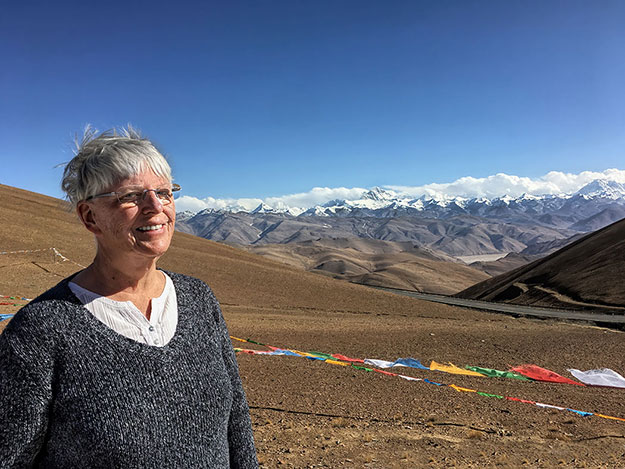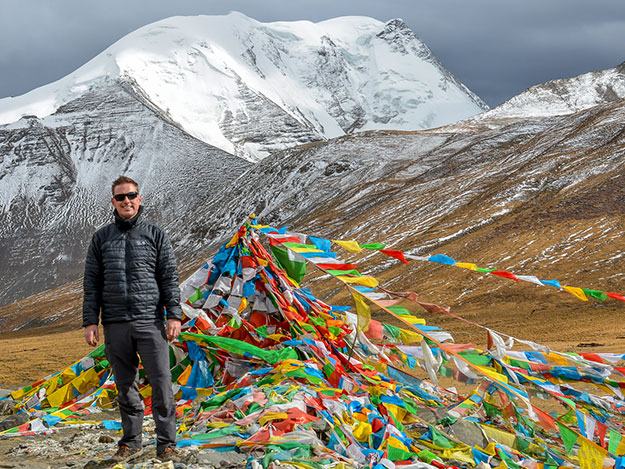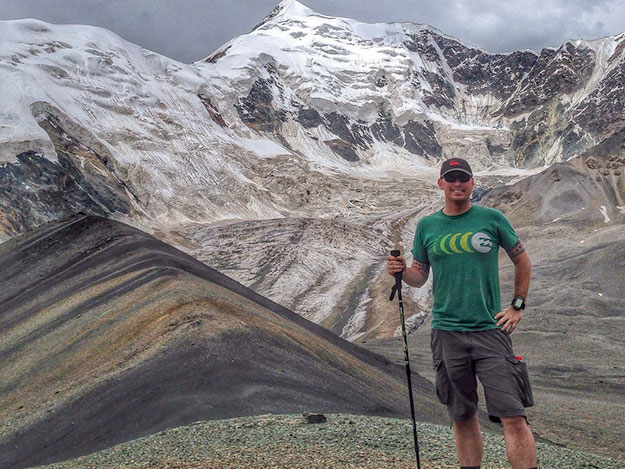I’d given up on ever traveling overland from Nepal to Tibet. Three times I had tried and failed. The first tour I booked in Kathmandu, a number of years ago, was cancelled when the Chinese government suddenly closed the border. My second try a couple of years later was much the same. When monks began setting themselves on fire to protest the Chinese occupation of Tibet during the anniversary of the 1959 Chinese invasion, the government again closed the border. I eventually learned that China closes Tibet to all foreign travelers from mid-February through early April every year. Unfortunately, the Kathmandu tour companies with which I had booked were clueless (read more about those closures here).
Lesson number one was to never work with an “aggregator.” All foreign travelers going to Tibet must be on an organized tour that includes a private vehicle, a driver, and a tour guide that are approved and licensed by the Chinese government. Additionally, travelers need a Tibet Travel Permit and a set travel itinerary, both of which can only be arranged by a tour operator. There are NO exceptions. NONE of the Nepali-owned travel and tour companies in Kathmandu can provide these services. They will take your money, but then turn you over to one of a handful of Tibetan-operated tour companies in the city. Of course, their fee is tacked on, so you end up paying more.

Armed with the correct information about annual border closures, I scheduled my next trip to Nepal for the fall of 2016. I was determined to find a Tibetan-owned firm in Kathmandu that specialized in Tibet tours. But it was not to be. On April 25, 2015, Nepal suffered a horrific earthquake that killed more than 22,000 people and destroyed the bridge connecting Nepal’s Friendship Highway with Tibet. Overland journeys between Kathmandu and Tibet ceased while a new land crossing was constructed. The land border between Nepal and Tibet would not be reopened to foreign travelers until August 28, 2017.
Fortunately, in the interim I had discovered Himalaya Journey, a tour company that specializes in tours of Tibet, Nepal, Bhutan, and Ladakh in northern India (affectionately known as “Little Tibet”). Himalaya Journey is owned by Jamin “Lobsang” York, an American who lived in Tibet for more than 14 years. Initially, Jamin worked for a non-government organization (NGO) that was founded by Tibetans, most of whom were retired government leaders. Their goal was to lift Tibetans out of severe poverty by providing opportunities that hadn’t been available to previous generations. They developed programs that allowed adults to learn how to use a computer, read and write Tibetan, speak and write basic Chinese, and learn English. The NGO then reached out to a group of Americans and British for assistance in supplying teachers for the school. And that is how Jamin ended up in Tibet…teaching English for the NGO.

Jamin soon realized how difficult it was for Tibetans to find jobs in the tourism sector, even after completing a two-year course through the NGO. Due to increasing tourism, jobs as English speaking cultural and trekking guides and private drivers were plentiful. There were also increasing opportunities to open small hotels, guesthouses, and restaurants aimed at the Western tourist. But most of these positions were going to Chinese who had migrated from eastern China. The businesses they opened employed only Chinese staff and Chinese guides, who cannot speak a word of Tibetan and know almost nothing about Tibetan culture, history, or religion. Chinese tour guides regularly tell foreign clients incorrect information about Tibet.
I’d given up on ever traveling overland from Nepal to Tibet…until I found Himalaya Journey
By 2006, Jamin had founded Tibetan Connections, a budget travel agency that specialized in small-group journeys across the Tibet Autonomous Region (TAR) as well as the eastern Tibet regions of Amdo and Kham. He exclusively hired Tibetans, most of whom were either still studying at the NGO or had recently graduated. Many of his employees dreamed of owning their own travel companies. Rather than seeing this as competition, Jamin trained them and eventually sent them off to start their own firms. In 2009 he sold that first tour company to a Tibetan man who continues to run it successfully. A year later, Jamin opened Himalaya Journey, which focuses on more mid-range and higher end journeys in Tibet and other Himalayan regions. As with his first company, all of the staff at Himalaya Journey are local Tibetan people.
Initially I found Jamin through his sister site, The Land of Snows, a platform that provides free travel advice and up-to-date information about traveling in the Himalayas. Through it, Jamin receives nearly 5,000 emails per year from travelers asking for advice. Free of charge and regardless of which travel agency people choose, he personally answers nearly 95% of these emails. Indeed, when I first began corresponding with him in 2016, he referred me to Tibetan-owned tour companies other than his own. Through a series of emails with Jamin, I grew more educated about traveling overland from Nepal to Tibet. He corrected voluminous misinformation on the Internet, including the following points.
The Most Important Things You Need to Know About Traveling Overland Between Nepal and Tibet
- At the risk of repeating myself, all foreign travelers going to Tibet must be on an organized tour that includes a private vehicle, a driver, and a tour guide, all of which must be approved and licensed by the Chinese government. However, this does not mean you must be on a group tour. An organized, approved tour can consist of one individual. Keep in mind that the fewer people on a tour, the more expensive it will be. Joining a group is a good way to keep costs down. Himalaya Travel specializes in small group travel that allows a good deal of customization and independence. My tour, for example, consisted of only eight people.
- Many, if not most companies conducting this overland tour begin in Kathmandu, Nepal and end in Lhasa, Tibet. This means that travelers will go from an altitude of 1,400 meters (4,593 feet) in Kathmandu to the 5,200-meter (17,056 foot) altitude at Everest Base Camp in Tibet in two short days. Anyone susceptible to high altitude sickness should be wary of this route, as it leaves little time to acclimate. Make no mistake about it, altitude sickness is serious. People have died from it. Instead, consider booking with a firm like Himalaya Journey, which does the tour in the opposite direction. I flew from Kathmandu to Lhasa, where I was picked up by my Tibetan guide and driver and taken to my hotel. Our group spent three days in Lhasa, acclimating to the city’s 3,650 meter (11,995-foot) altitude before beginning our overland journey. We climbed a bit higher each day, descending to lower elevations at night, as recommended for high-altitude adjustment. Previously, I got sick at altitudes higher than 4,000 meters, but by increasing the altitude incrementally each day, I was able to stay overnight at Everest Base Camp without the need for supplemental oxygen and only minor discomfort.
- If you plan to travel from Kathmandu to Tibet, whether flying to Lhasa or going overland, you MUST get your Chinese visa from the Chinese Embassy in Kathmandu. A little-known but extremely important fact is that the Kathmandu embassy will cancel ANY Chinese visa that is in your passport when it grants a Tibet Travel Permit. It doesn’t matter if you have a tourist visa, spousal visa, business visa, work visa, student visa, or a high-end investment visa – it will be cancelled. These days, the only tourist visa available to Americans from Chinese embassies and consulates in the USA is a 10-year visa, at a cost of $140. If you already have a Chinese visa in your passport and plan to take an overland trip between Nepal and Tibet, it is advisable to fly into mainland China first (Chengdu is a popular choice). Your tour operator will mail your TTP to the hotel where you are staying, at which time you can proceed to Lhasa. This way, your pricey Chinese visa won’t be cancelled.
- Tibet is closed to foreign travelers each year from mid-February through early April.
- The best times to visit Tibet are from early April through mid-June and again from mid-September through the end of November. Other times of the year, the mountains and landscape are often obscured by clouds.
- The weather in Tibet is not as cold as you might think. Most areas of Tibet can still be quite pleasant in September and early October with highs from 66 – 73 degrees F (19 – 23 degrees C)….perfect conditions for trekking, photography, an cultural experiences. Even in mid-winter, Lhasa has lots of sunshine and still has highs between 45 and 50 degrees F (7 – 10 degrees C). Many parts of North America and Europe are far colder in winter.
- Seeing Mount Everest from the Nepal side involves either taking a flightseeing tour or making a long, arduous trek. In Tibet, a road leads directly to Everest Base Camp, where visitors enjoy a close-up view of the world’s highest mountain in all its majesty.
- It is an absolute myth that travelers to Tibet must be accompanied by a tour guide every moment during their tour. Our group was given ample opportunity to wander unaccompanied in each of the cities we visited and to speak with whomever we wished.

Finally, a note about Himalaya Journey and The Land of Snows, as I was somewhat confused by the need for two separate sites. Jamin originally set up The Land of Snows as a portal where anyone could ask questions about travel in Tibet, regardless of the tour company they select. Clients who decide to book with Jamin’s firm are then handled through the Himalaya Journey website.
Happily, I did finally make it to Tibet. In December of 2018, I checked The Land of Snows website and learned that the land border had finally been reopened. Making no mention of our previous correspondence, I again contacted Jamin and asked him to recommend a tour operator. He replied almost immediately. To my astonishment, more than 2.5 years after my last email, he remembered me. This time, all the planets must have been aligned. He had an overland journey scheduled in April this year, with one remaining available spot. The rest, as they say, is history.
In retrospect, I’m glad that my three earlier attempts to visit Tibet were unsuccessful, as I would likely not have traveled with Himalaya Journey. For anyone considering overland travel to Tibet, I highly and unreservedly recommend them.
Email Jamin at: [email protected] or connect through social media:
Facebook: The Land of Snows
Instagram: The Land of Snows
If you enjoyed this article about the best way to travel overland from Nepal to Tibet, you may also want to check out other stories about my experience in Tibet:
Climbing 2,000 Steps to Tour the Potala Palace in Lhasa, Tibet
The Superstitious Practice of Placing a Smudge of Soot on a Tibetan Child’s Nose
Yamdrok Lake, Jewel of the High Tibetan Plateau
Giant Shakyamuni Buddha Statue at Pelkor Chode Monastery in Gyantse, Tibet
The Weird, Wonderful Critters of Tibet
Vista of Mount Everest from Geu La Pass
VIDEO: The Famous Debating Monks of Tibet
Women Wearing Traditional Chubas at Sakya Monastery, Tibet
Conquering the Rarefied Air at Everest Base Camp in Tibet
Battle for Gyantse Dzong, an Ancient Fortress in Southern Tibet
One -of-a-Kind: Phuntsoling Monastery in Tibet

thanks for sharing great content.
Tibet is always amazing as it is …. nice photo and glad to you made it
Thanks so much Gelek
Very good post. I am a very good friend of Jamin and we work together very closely for many year. thank you for the great post
Thanks Tenzin. It was a well-done tour and I enjoyed every moment, even when I could hardly breathe at Everest Base Camp.
Great article about the tips for travel between Nepal and Tibet.
I am planning to so this trip after the COVID-19
Thank you so much and your blog will help millions.
You’re welcome Alexander. I’m very pleased to know it will help you. It’s a wonderful way to experience Tibet.
Very informative article, since I know it always complicate organize overland trip from Kathmandu to Lhasa.
Thanks Dil. Glad you found it helpful.
Very interesting photo at Tibet !
Fantastic info, lots of stuff I had no idea on and would make big errors if I didn’t read this first. Himalayas are on the list for one day so will refer back here for the detailed info. Thanks again.
You’re very welcome Barry. Glad you found it helpful.
Your site looks great Mani! Good luck with everything.There are some great tips in here – loved this post.Thank you for the wonderful links and resources
Thank you for the wonderful links and resources
This was an excellent read, Barbara! Very informative and important, and your sequence of events was captivating.
Thanks Crystal. I’m hpapy I finally figured out a way to get there.
Wonderful info and wonderful pix! I still hope to make this journey some day.
Thanks so much Roxan. Hope you get to make the trip some day!